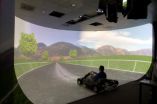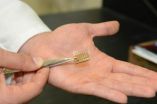(Press-News.org) ANN ARBOR—It looks like Mother Nature was wasting her time with a multimillion-year process to produce crude oil. Michigan Engineering researchers can "pressure-cook" algae for as little as a minute and transform an unprecedented 65 percent of the green slime into biocrude.
"We're trying to mimic the process in nature that forms crude oil with marine organisms," said Phil Savage, an Arthur F. Thurnau professor and a professor of chemical engineering at the University of Michigan.
The findings will be presented Nov. 1 at the 2012 American Institute of Chemical Engineers Annual Meeting in Pittsburgh.
Savage's ocean-going organism of choice is the green marine micro-alga of the genus Nannochloropsis.
To make their one-minute biocrude, Savage and Julia Faeth, a doctoral student in Savage's lab, filled a steel pipe connector with 1.5 milliliters of wet algae, capped it and plunged it into 1,100-degree Fahrenheit sand. The small volume ensured that the algae was heated through, but with only a minute to warm up, the algae's temperature should have just grazed the 550-degree mark before the team pulled the reactor back out.
Previously, Savage and his team heated the algae for times ranging from 10 to 90 minutes. They saw their best results, with about half of the algae converted to biocrude, after treating it for 10 to 40 minutes at 570 degrees.
Why are the one-minute results so much better? Savage and Faeth won't be sure until they have done more experiments, but they have some ideas.
"My guess is that the reactions that produce biocrude are actually must faster than previously thought," Savage said.
Faeth suggests that the fast heating might boost the biocrude by keeping unwanted reactions at bay.
"For example, the biocrude might decompose into substances that dissolve in water, and the fast heating rates might discourage that reaction," Faeth said.
The team points out that shorter reaction times mean that the reactors don't have to be as large.
"By reducing the reactor volume, the cost of building a biocrude production plant also decreases," Faeth said, though both she and Savage cautioned that they couldn't say for sure whether the new method is faster and cheaper until the process is further developed.
Current commercial makers of algae-based fuel first dry the algae and then extract the natural oil. But at over $20 per gallon, this fuel is a long way from the gas pump.
"Companies know that that approach is not economical, so they are looking at approaches for using wet algae, as are we," Savage said.
One of the advantages of the wet method is that it doesn't just extract the existing fat from the algae—it also breaks down proteins and carbohydrates. The minute method did this so successfully that the oil contained about 90 percent of the energy in the original algae.
"That result is near the upper bound of what is possible," Savage said.
Before biocrude can be fed into the existing refinery system for petroleum, it needs pre-refining to get rid of the extra oxygen and nitrogen atoms that abound in living things. The Savage lab also is developing better methods for this leg of biofuel production, breaking the record with a biocrude that was 97 percent carbon and hydrogen earlier this year. A paper on this work is currently under review.
Once producing biofuel from algae is economical, researchers estimate that an area the size of New Mexico could provide enough oil to match current U.S. petroleum consumption. And, unlike corn produced for ethanol—which already accounts for half that area—the algae won't need to occupy good farmland, thriving in brackish ponds instead.
INFORMATION:
The research, "The Effects of Heating Rate and Reaction Time on Hydrothermal Liquefaction of Microalgae," was funded by the Emerging Frontiers in Research and Innovation program of the National Science Foundation. The university is pursuing patent protection for the intellectual property, and is seeking commercialization partners to help bring the technology to market.
Abstract: https://aiche.confex.com/aiche/2012/webprogram/Paper280193.html
Savage Lab: http://savageresearchlab.wordpress.com
END
Scientists have identified a molecular 'flag' in women with breast cancer who do not respond or have become resistant to the hormone drug tamoxifen.
Tamoxifen – used alongside traditional chemotherapy and radiotherapy – blocks the female hormone oestrogen that, in certain breast cancers, is required by the tumour to grow; it has been shown to improve cancer survival rates by up to one third.
However, about one third of patients with the appropriate type of breast cancer – known as oestrogen receptor positive breast cancer – do not respond to tamoxifen or develop resistance ...
This press release is available in German.
Fog is an atmospheric phenomenon that afflicts millions of drivers every day, impairing visibility and increasing the risk of an accident. The ways people respond to conditions of reduced visibility is a central topic in vision research. It has been shown that people tend to underestimate speeds when visibility is reduced equally at all distances, as for example, when driving with a uniformly fogged windshield. But what happens when the visibility decreases as you look further into the distance, as happens when driving in ...
"Nature teaches beasts to know their friends," wrote Shakespeare. In humans, nature may be less than half of the story, a team led by University of Colorado Boulder researchers has found.
In the first study of its kind, the team found that genetic similarities may help to explain why human birds of a feather flock together, but the full story of why people become friends "is contingent upon the social environment in which individuals interact with one another," the researchers write.
People are more likely to befriend genetically similar people when their environment ...
Cold Spring Harbor, N.Y. – Cancer cells grow fast. That's an essential characteristic of what makes them cancer cells. They've crashed through all the cell-cycle checkpoints and are continuously growing and dividing, far outstripping our normal cells. To do this they need to speed up their metabolism.
CSHL Professor Adrian Krainer and his team have found a way to target the cancer cell metabolic process and in the process specifically kill cancer cells.
Nearly 90 years ago the German chemist and Nobel laureate Otto Warburg proposed that cancer's prime cause was a change ...
Until now, we knew that ticks primarily transmit two pathogens to humans in Switzerland: the bacterium Borrelia burgdorferi – which causes borreliosis – and the early-summer-meningoencephalitis virus, which can cause cerebral inflammation. Now, microbiologists from the University of Zurich confirm the existence of another tick disease in Switzerland – neoehrlichiosis.
The pathogenic bacteria Candidatus Neoehrlichia mikurensis was first discovered in ticks and rodents in Europe and Asia in 1999. In 2010, Head of Molecular Diagnostics at the Institute of Medical Microbiology ...
Older adults left in the wake of Hurricane Sandy will likely suffer disproportionately in the days ahead, based on data from other recent natural disasters.
For example, three quarters of those who perished in Hurricane Katrina were over the age of 60, according to the spring 2006 edition of Public Policy & Aging Report from The Gerontological Society of America (GSA). Similarly, a recent issue of the Journals of Gerontology Series A: Biological Sciences and Medical Sciences reported that the May 2008 earthquake in Wenchuan, China, was associated with a twofold increase ...
A new RAND Corporation study examining the impact of retail medical clinics on the receipt of primary medical care finds mixed evidence about whether the clinics may disrupt doctor-patient relationships.
The study found that people who visit retail medical clinics are less likely to return to a primary care physician for future illnesses and have less continuity of care. However, there was no evidence retail medical clinics disrupted preventive medical care or management of diabetes, two important measures of quality of primary care.
The findings, published online by ...
Stanford University scientists have built the first solar cell made entirely of carbon, a promising alternative to the expensive materials used in photovoltaic devices today.
The results are published in the Oct. 31 online edition of the journal ACS Nano.
"Carbon has the potential to deliver high performance at a low cost," said study senior author Zhenan Bao, a professor of chemical engineering at Stanford. "To the best of our knowledge, this is the first demonstration of a working solar cell that has all of the components made of carbon. This study builds on previous ...
Clinical hypnosis can effectively reduce hot flashes and associated symptoms among postmenopausal women, according to a new study conducted by researchers at Baylor University's Mind-Body Medicine Research Laboratory.
Hypnotic relaxation therapy reduced hot flashes by as much as 80 percent, and the findings also showed participants experienced improved quality of life and a lessening of anxiety and depression.
The mind-body therapy study of 187 women over a five-week period measured both physical symptoms of hot flashes and women's self-reporting of flashes. The women ...
There's good news for fans of black raspberries: A U.S. Department of Agriculture (USDA) scientist and his commercial colleague have found black raspberries that have resistance to a disease-spreading aphid.
Agricultural Research Service (ARS) horticulturist Chad Finn with the agency's Horticultural Crops Research Unit in Corvallis, Ore., and colleague Michael Dossett of Agriculture and Agri-Food Canada are the first to find and report black raspberry resistance to the large raspberry aphid.
ARS is USDA's chief intramural scientific research agency, and this research ...

